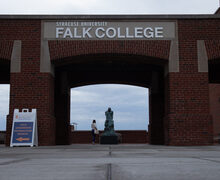Breaking down Gov. Kathy Hochul’s record $216.3 billion state budget proposal
Elizabeth Billman | Senior Staff Photographer
The proposal outlined the Department of Transportation’s capital plan, which will leverage federal funding commitments to support the final phases of major infrastructure projects including the replacement of I-81.
Get the latest Syracuse news delivered right to your inbox.
Subscribe to our newsletter here.
Gov. Kathy Hochul announced New York state’s $216.3 billion budget proposal for the 2023 fiscal year on Tuesday, a record-high amount.
The budget covered $32.8 billion over five years for transportation infrastructure, including $1.1 billion for the replacement of Syracuse’s Interstate 81 viaduct.
The Daily Orange summarizes what you should know in the budget, including measures that will directly affect the city of Syracuse and central New York.

Danny Kahn | Design Editor
Housing and infrastructure
The proposal outlined the Department of Transportation’s capital plan, which will leverage federal funding commitments to support the final phases of major infrastructure projects including the replacement of I-81.
In 2019, the DOT announced it would recommend a plan to remove the I-81 viaduct and replace it with a community grid alternative of city streets in the area.
Syracuse University Chancellor Kent Syverud announced the university’s endorsement of the plan in 2019. Syracuse community members have advocated for more local hiring opportunities in the project to reconnect the communities that had been displaced by the construction of the viaduct decades ago.
New York state will also benefit from President Joe Biden’s $1.2 trillion infrastructure bill that went into effect last year. About $13.4 billion in federal funding will flow into New York state over the next five years, according to the budget.
The budget advances a new five-year housing plan, which will invest $25 billion to create and preserve 100,000 affordable homes, including 10,000 homes with support services for vulnerable populations.
Hochul also proposed $100 million for the state’s Downtown Revitalization Initiative, a program that aims to transform the state’s downtown neighborhoods into vibrant communities. Communities are nominated by the state and will be awarded funding to develop a strategic plan that advances the community’s vision for revitalization.
We are responding to this historic moment with a historic level of funding, but we are not creating recurring expenses or new programs we can’t pay for. For the first time ever, we have no out-year gaps. pic.twitter.com/8sEbRE1eP8
— Kathy Hochul (@GovKathyHochul) January 18, 2022
Pandemic recovery, response
New York is investing $10 billion into the health care system, including more than $4 billion to support wages and bonuses for health care workers, and $2.4 billion for health care capital infrastructure and improved laboratory capacity. The budget did not specify how these investments will be distributed.
Hochul announced that the state will rebuild and grow the health care workforce by 20% over the next five years through a program designed to strengthen home care, expand access to health care education and recruit professionals for people in underserved areas.
The state will expand Medicaid eligibility to low-income New Yorkers aged 65 and up and those with disabilities so that they can maintain Medicaid eligibility after they become eligible for Medicare.
The budget also includes $12.4 million for the Department of Labor’s enforcement of worker protections. Legislation submitted alongside the budget prohibited non-compete agreements for workers making below minimum wage, limits for worker mobility and “no-poach” agreements under New York state antitrust law.
Additionally, the budget proposed $250 million in tax credits to small businesses that took on pandemic-related capital expenses, in addition to a $200 million flexible grant program for early-stage businesses that opened amid the pandemic.
Public safety
Hochul’s budget proposed state investments to strengthen gun violence prevention in law enforcement agencies and community organizations and in education and job skills training for incarcerated individuals.
A total of $215,000 will be provided to triple the state’s gun violence intelligence resources. The state will provide $13.1 million to expand law enforcement partnerships between State Troopers and local law enforcement agencies.
The budget also includes $527,000 in funding to enhance the Social Media Analysis Unit at New York State Intelligence Center. The team will perform daily analysis of public social media activity related to school violence threats, gang activity and illegal firearms, according to the budget.
Incarcerated people will be eligible for state financial aid through the Tuition Assistance Program as the budget repeals a 1995 state law that prohibits it. The budget also abolishes parole supervision fees.
The budget also initiated a pilot program that secures suitable residence for parolees who otherwise would have been released into the shelter system. The program will set up a residential treatment facility to provide parolees with stable housing for 90 days as they look for a job and permanent home. The parolees will also be eligible for a temporary stipend to reduce household spending for 12 weeks.
Higher education
About 1.2 million students enrolled into New York’s higher education institutions as of fall 2020, according to the budget. The budget proposed to expand the Tuition Assistance Program for part-time students in degree programs, as well as part-time community college students in high-demand workforce credential programs.
The budget proposed an additional $24 million in funding for educationally disadvantaged students through programs and training centers administered by CUNY, SUNY and private colleges, a 10% increase.
The budget revealed that funding for these programs has doubled since 2012 and currently totals $271 million.
In addition, the budget provides SUNY and CUNY with $53 million each to hire approximately 880 new full-time faculty at both four-year colleges and community colleges — 340 at SUNY and 540 at CUNY. The budget will also increase operating support for the two university systems through reimbursement by $127 million.
Published on January 23, 2022 at 11:55 pm
Contact Francis: [email protected] | @francis_towne





